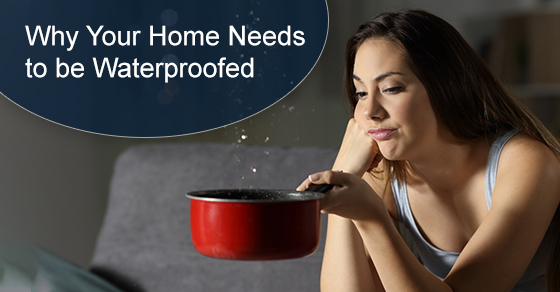Why Your Home Needs to be Waterproofed

When it comes to keeping your home safe and secure, waterproofing is essential. Most homeowners overlook this key element and end up paying for it when there is a leak. While many consider water damage to be an aesthetic problem, it often causes much more trouble. It is important to know that by the time you notice a leak, there has already been structural damage. This is because the water often seeps in slowly and spends time trapped in your walls and concrete. During that time and most often before you even notice, it starts to cause mould and decay.
To fully understand the damage that water can do to your home, it is important to understand its effect on your home’s concrete.
Concrete and Water
Unfortunately for homeowners, concrete absorbs water. Due to its complex chemical components, concrete and similar materials like bricks, stones, and mortars have surfaces that are full of oxygen atoms. When these surfaces come into contact with water, they form bonds with the water molecules. Essentially, they allow water in because of their makeup.
Concrete is created by mixing together cement, sand, aggregate, and water. It is considered one of the strongest and most durable building materials. These ingredients mixed together allow for carbonation of the cement. While this is what hardens the concrete, it also reduces the alkalinity. Yet, it is the alkalinity that protects steel in concrete-steel constructions.
Creating concrete relies on the reaction of the ingredients to the water. This is what gives the material its strength and also its workability. In most construction situations, there is a significant amount of water added to the mixture to create concrete. The reason behind this is that it is simply easier to work with during the building process. However, the drawback is the amount of water that is used often weakens the concrete, by causing pores. These pores will stay in the mixture no matter how much the concrete is compressed together.
Unfortunately, the impact of weather on homes and other buildings cannot be avoided. When it comes to the damage that rain and other precipitation can have on materials like concrete or stone, this has been exasperated by toxic elements getting into the water molecules. These elements also make their way into the concrete through natural processes.
The results are major structural damage that can cause a risk to homes and buildings.
Although many homeowners believe their homes to be watertight, the makeup of concrete means there is always a risk of water getting in at some point. When this happens, it can damage the steel inside the building, plasterboards, cement tiles, paint, floor joints, beams, studs, frames, and more. In addition, water in the home can cause electrical and health problems, particularly for those with asthma or allergies.
However, there are ways to improve the waterproofing of your home.
Waterproofing Your Home
To offer your home the ultimate protection from water, there are some steps you can take. These include additional features to your house and a considerate approach to the building materials and processes you use during construction.
-
Additional Waterproofing Features
One of the ways to help your home be more water-free is to redirect any precipitation away from your house. This includes ensuring you have functioning drainage from your roof. Cleaning your rain gutters regularly, checking that they direct water away from the foundation of your home, and using flashings are some of the best ways that homeowners can prevent water leaks.
-
Protection of Building Materials
While concrete is a popular building material, it is not 100 percent leak-proof. That is why homeowners may want to consider adding some extra protection in the form of a surface coating to prevent water from getting inside. Many hardware stores carry waterproofing and sealants to protect the outside of your home. These can be applied to any cracks or openings that may allow water to get inside the house. You can also consider applying a liquid membrane, which is sold in sheets, to add some extra protection to your home.
-
Maintenance
Taking care of the exterior of your home can go a long way in keeping you dry inside. For example, if your exterior paint is starting to chip away, consider putting on a new coat before the weather gets bad. Paint does more than make your home look nice, it can also help to keep rain, snow, and other moisture out of your interior walls. It is also important to check your structure for cracks regularly. Most importantly, ensure that your roof is in good condition. Because rain and snow gather on the roof, you want to be sure that it is draining correctly. Accumulation over the winter months can weaken your roof and leave you at risk for leaks.
-
Expert Advice
Whether you are building a new home or renovating the one you are currently in, talk to your plumber about ways to waterproof your home. At Brothers Plumbing, we use state-of-the-art materials to help prevent water seepage before it starts. If you have already had a leak in your house, you know the headache that it can cause. By seeking expert advice from those in the industry, you can save yourself future trouble.
Conclusion
We know that keeping your home safe and secure for you and your family means waterproofing your house. While many homeowners believe that water damage is simply an aesthetic problem, unfortunately, water can cause serious problems to your home’s structure. Often, by the time you notice the leak or stain, this damage has already begun. If you suspect a leak in your home, let us help you isolate and fix the problem.
For more information about waterproofing your home, call Brothers Plumbing at 1-800-742-0018 or contact us here.
Posted By Brothers Plumbing
0 Comment
